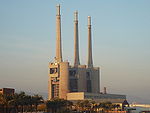Energy in Montecara: Difference between revisions
| Line 83: | Line 83: | ||
{{also|Taxation in Montecara}} | {{also|Taxation in Montecara}} | ||
The [[Colegio|Secretariat of Planning and the Environment]] has authority over energy regulation in Montecara. | The [[Colegio|Secretariat of Planning and the Environment]] has authority over energy regulation in Montecara. | ||
{{Template:Montecara topics}} | {{Template:Montecara topics}} | ||
[[Category:Montecara]] | [[Category:Montecara]] | ||
Revision as of 17:02, 5 May 2020
Electricity
| Data | |
|---|---|
| Electricity coverage | 100% |
| Continuity of supply | 99.99% |
| Installed capacity (2017) | 4795 MW |
| Share of fossil energy | 92.28% |
| Share of renewable energy | 7.72% |
| Average electricity use (2017) | 8,194 kW·h per capita |
| Services | |
| Share of private sector in generation | 100% |
| Competitive supply to large users | No |
| Competitive supply to residential users | No |
| Institutions | |
| Responsibility for transmission | Comega |
Montecara consumes about 14.35 billion kW·h of electricity per year. The government claims that the country is in the process of moving away from fossil fuels and toward sustainable energy, but it badly lags behind schedule in its goal, set in 2000, of achieving 100% renewable electricity by 2025. Less than ten percent of the electricity generated in Montecara comes from a renewable source, with the remaining more than ninety percent coming from oil and natural gas. There are several obstacles to the increased use of renewables: limited land area means that there is little free space to deploy solar panels, the terrain is not generally favorable to onshore wind power, and high land values mean that land-intensive renewable plants are prohibitively expensive to build and maintain. Moreover, the continuous and cost-competitive supply of oil and gas from Tsabara means that renewables cannot compete on price.
Nuclear power is a highly contentious political issue. Montecara has been a nuclear-free zone since 1985 in response to plans by Comega to build a boiling water reactor.
An interconnector cable allows electricity to be exported to and imported from mainland Euclea as needed.
Power plants
| Name | Image | Type | Capacity (MW) | Commissioned |
|---|---|---|---|---|
| Nùvol power plant | Natural gas (primary) Oil (secondary) |
1050 (3 × 350) | 1982 | |
| Siròco Nòvo array | Offshore wind | 309 | 2013 | |
| Cocàl regeneration plant | Waste-to-energy | 85 | 1999 |
Sources
Twin oil and natural gas pipelines run from Tsabara to mainland Euclea underneath Montecara. These are tapped off for use in power plants and transportation. These pipelines provide the vast majority of oil and gas resources used locally, but some oil and liquefied natural gas arrives by ship as well and is usually re-exported.
Regulation
The Secretariat of Planning and the Environment has authority over energy regulation in Montecara.


